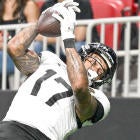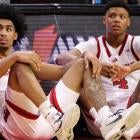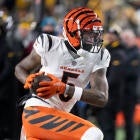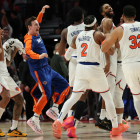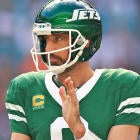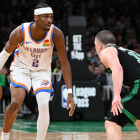A federal judge granted preliminary approval Tuesday to an amended settlement between the NCAA and a group of college athletes who sued how the association handled concussions.
U.S. District Judge John Z. Lee’s approval came with one significant change that in part has delayed resolving the case. The athletes could still sue their university and the NCAA as a class under certain terms, meaning the NCAA and schools don't have the blanket immunity moving forward they sought.
The settlement would release all class-wide claims relating to concussions, subconcussive hits or contact. Current and former college athletes could still sue for personal injuries and “class claims that do not relate in any way to medical monitoring or medical treatment of concussions or sub-concussive hits or contact.”
Both parties must still agree to amendments in the settlement. First submitted in July 2014, the agreement would create a $70 million fund to test thousands of current and former athletes for brain trauma and put aside $5 million for research. In addition, NCAA guidelines for medical care by universities would change moving forward.
“While we are pleased the court has provided a preliminary pathway to provide significant resources for the medical monitoring of student-athletes who may suffer concussions, we are still examining the conditions placed on preliminary approval,” NCAA chief legal officer Donald Remy said in a statement.
Jay Edelson, a Chicago attorney who intervened in the case, said he loves the decision and will start filing lawsuits against schools within the next couple weeks.
"We think there's nothing stopping them now," Edelson said. "It's going to be the large schools that have had systematic issues. It's not going to be a surprise who they are when we first start filing."
Edelson's interpretation of the ammended settlement is that class-action suits can be filed on a school-by-school basis -- not a national class-action -- and as long as they don't involve medical monitoring.
"The medical monitoring was always the tail that wags the dog," Edelson said. "That’s just about people getting a test to see if they can get a concussion. People who were badly injured know they have concussions. The key thing is this is not a done deal. (The plaintiffs' attorney) Steve Berman will be happy going forward with this deal. The key question is whether the NCAA still wants to go forward. That's not clear. They really want the class release. What the NCAA ends up instead of facing one big suit is they face dozens of moderate-size suits, which doesn’t sound like the biggest win for them."
Berman said he has "no issues" with the judge's new terms. "Hopefully we will get this before the judge in mid-February," he said.
When asked how susceptible he thinks the settlement would make individual universities to class-action claims, Berman responded, “I don’t see a big risk. There just aren’t scores of concussed kids that would make up a class at each school.”
The litigation was originally filed in 2011 by former Eastern Illinois football player Adrian Arrington, who sustained several head injuries in college and argued the NCAA neglected concussions. Additional cases became consolidated with Arrington, who later opposed the settlement because individual athletes aren’t getting paid medical costs.
The settlement would create a 50-year medical monitoring program at $70 million to cover diagnostic medical expenses for athletes, not their actual treatment. The NFL’s settlement with players over concussions is for approximately $900 million and includes millions of dollars going to players who suffer from neurological diseases.
Back in 2010, the NCAA began requiring every school to have a concussion-management plan. Documents released in the Arrington case in 2013 showed the NCAA essentially had no oversight over these concussion management plans.
In a 53-page opinion, Lee wrote that he could not rule that the NCAA’s alleged conduct injured college athletes in “the same, unvarying” way as conclusions reached in the NFL case.
“Rather, the facts produced in discovery present a multitude of potential permutations regarding whether the NCAA breached a duty to protect its athletes and caused any particular plaintiff injury,” Lee wrote. “And the need to make individual, fact intensive determinations as to liability with respect to each class member eclipses any common issues as to whether the NCAA had a duty to protect players from concussion-related risks, breached that duty, and fraudulently concealed those risks.”
Lee outlined six changes the NCAA agreed to implement regarding concussion policies (some of which are already in place):
• Require all athletes to undergo preseason baseline testing for each sport prior to their first practice or competition.
• Revise the NCAA guidelines so an athlete diagnosed with a concussion will be prohibited from returning to play on the same day and must be cleared by a physician before coming back.
• Require medical personnel who are trained in concussions to attend all contact-sport games and practices for Divisions I, II and III. Contact sports are defined as football, lacrosse, wrestling, ice hockey, field hockey, soccer and basketball.
• Have the NCAA institute “a uniform process for schools to report diagnosed concussions and their resolution, and for concerned persons to report potential problems directly to the NCAA.”
• Require NCAA schools to provide approved concussion education and training to athletes, coaches and athletic trainers before each season.
• Have the NCAA provide education for faculty to accommodate students suffering from concussions.
Lee had previously said he needed to understand “the range of actions” the NCAA may take against a member for either intentionally or inadvertently failing to comply with settlement terms, and any sort of enforcement mechanism. NCAA members have wrestled with whether to adopt rules attached to concussion guidelines.
In Tuesday’s opinion, Lee wrote that the settlement “now encourages the schools to implement the concussion management protocols, by requiring that the schools provide written certification of compliance in order to be included as Released Parties under the agreement.”
Previously, Lee was concerned about how few locations would be available for medical monitoring tests. The number of locations has expanded to 33 across the country, with an assumption that 50 percent of class members would live within 50 miles of a location and 70 percent would be within 100 miles. Athletes who live more than 100 miles away could get reimbursed to travel to the closest location or request access to a closer medical provider.
The settlement requires a publicity campaign 10 years into the 50-year monitoring program. Lee recommends publicity campaigns every 10 years to ensure class members are aware of the testing.
Four former college athletes -- Derek Owens, Angelica Palacios, Kyle Solomon and Arrington -- are set to receive $5,000 each as named plaintiffs since they were deposed in the case. Additional plaintiffs who were not deposed will each get $2,500.
The NCAA agreed that it will not oppose plaintiffs’ request for an award of attorneys’ fees of up $15 million and out-of-pocket expenses up to $750,000. Attorney fees and costs must still be approved by Lee. A status hearing for the case is set for Thursday in Chicago.
Follow and read more from Jon Solomon on Facebook and Twitter.
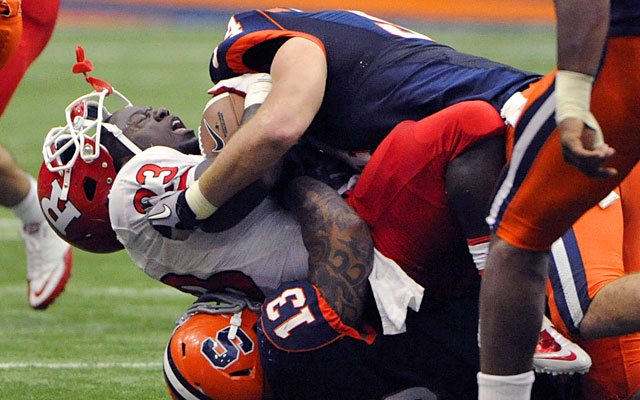
![[object Object] Logo](https://sportshub.cbsistatic.com/i/2020/04/22/e9ceb731-8b3f-4c60-98fe-090ab66a2997/screen-shot-2020-04-22-at-11-04-56-am.png)







